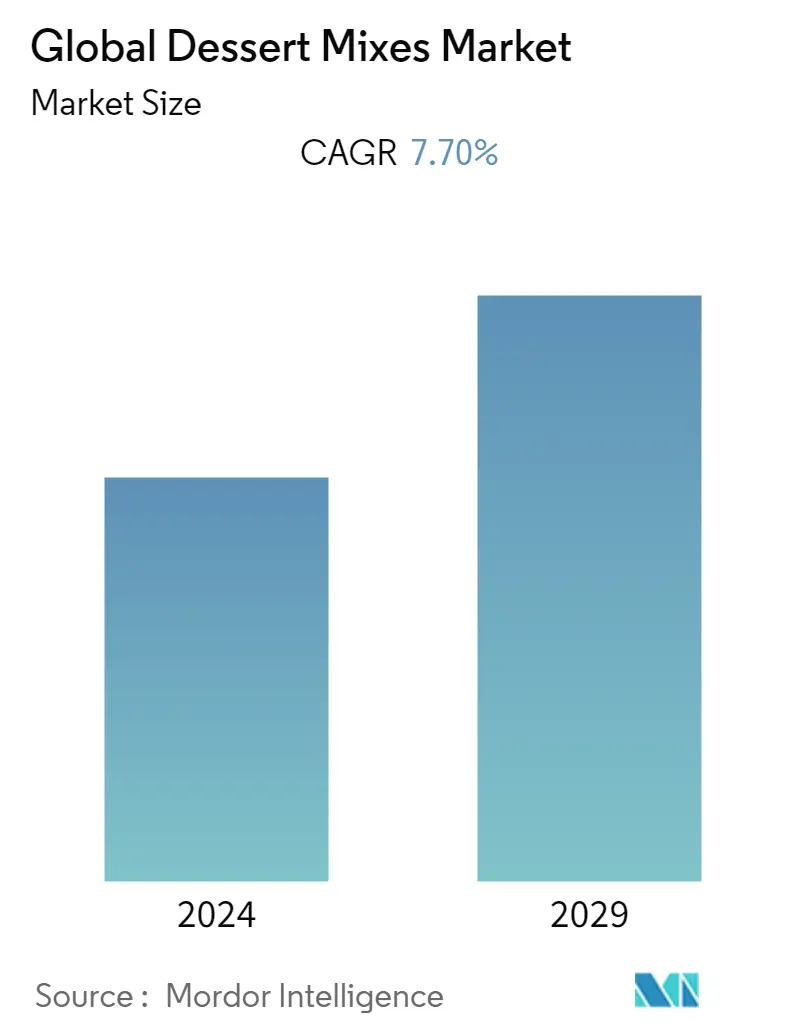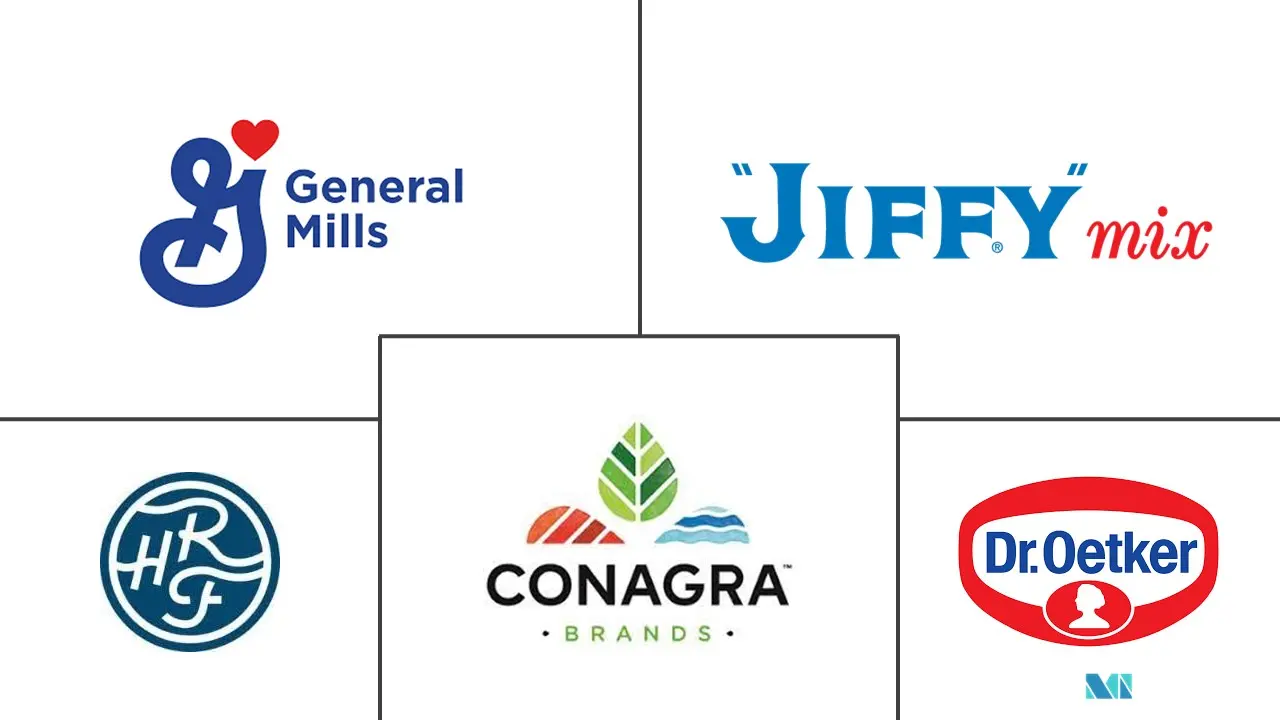Market Size of Global Dessert Mixes Industry

| Study Period | 2019 - 2029 |
| Base Year For Estimation | 2023 |
| CAGR | 7.70 % |
| Fastest Growing Market | Asia-Pacific |
| Largest Market | North America |
| Market Concentration | Medium |
Major Players
*Disclaimer: Major Players sorted in no particular order |
Dessert Mixes Market Analysis
The dessert Mixes Market is projected to register a CAGR of 7.7 % during the forecast period, 2022-2027.
Convenient foods have grown in popularity, particularly among working families, youngsters, and people who live in hostels, because they require less time to prepare any type of food at home. Furthermore, rising consumable income levels in developing countries have allowed people to spend freely on satisfying their taste buds, increasing in demand for dessert mixes. Traditional desserts like gulab jamun, kulfi, and Falooda, to name a few, are becoming more and more popular. However, contemporary chefs prefer quick and simple methods over more time-consuming traditional ones, which has led them to adopt instant dessert mixes like gulab jamun mix and Falooda mix, among others. Thus, with the rising consumption of sweets over the world the market is expected to gain momentum during the forecast period.
In short term, The pandemic situation has prompted brand manufacturers to enhance their online presence and collaborate with domestic suppliers to increase their consumer base because more people are familiar with the widespread online ordering and home delivery choices. Additionally, desserts have typically been considered an afterthought, but as more dessert-specific websites and online grocery stores with a variety of dessert products have popped up, they are quickly replacing pub gatherings as the preferred option for young people looking to meet friends and for consumers looking for a treat after months of restriction.
Dessert Mixes Industry Segmentation
A dessert mix is a powdered or semi-fluid mixture of ingredients and flavors that may be easily used to make sweet dishes. The global dessert mixes market (henceforth referred to as the market studied) is segmented by Product Type, Flavor, Category, Distribution Channel, and Geography. By Product type, the market is segmented into cake mix, brownie mix, ice cream mix, and other products. By flavor, the market is segmented into chocolate, vanilla, red velvet, and others. By category, the market is segmented into organic and conventional. Based on the distribution channel, the market studied is segmented into hypermarkets/supermarkets, convenience stores, online retail stores, and other distribution channels. It provides an analysis of emerging and established economies across the world, comprising North America, Europe, South America, Asia-Pacific, the Middle East, and Africa. For each segment, the market sizing and forecasts have been done on the basis of value (in USD million).
| By Product | |
| Cake Mix | |
| Brownie Mix | |
| Ice-Cream Mix | |
| Other Products |
| By Flavor | |
| Chocolate | |
| Vanilla | |
| Red velvet | |
| Others |
| By Category | |
| Organic | |
| Conventional |
| By Distribution Channel | |
| Hypermarkets/Supermarkets | |
| Convenience Stores | |
| Online Retail Stores | |
| Other Distribution Channels |
| By Geography | |||||||||
| |||||||||
| |||||||||
| |||||||||
| |||||||||
|
Global Dessert Mixes Market Size Summary
The global dessert mixes market is experiencing significant growth, driven by the increasing demand for convenient food options among working families, young adults, and hostel residents. This trend is further fueled by rising disposable incomes in developing regions, allowing consumers to indulge in traditional and modern desserts with ease. The popularity of instant dessert mixes, such as gulab jamun and Falooda mixes, is on the rise as contemporary chefs seek quicker preparation methods. The pandemic has accelerated the shift towards online shopping and home delivery, with dessert-specific websites and online grocery stores gaining traction. This shift has transformed desserts from being an afterthought to a primary choice for social gatherings and personal treats, particularly among younger consumers.
The market is also witnessing a surge in demand for gluten-free and "free from" dessert mixes, driven by increased health awareness and lifestyle choices among consumers. Regulatory bodies, such as the Food Safety and Standards Authority of India, are influencing market dynamics by setting stringent labeling standards, which in turn encourage the production and consumption of gluten-free products. The Asia-Pacific region is experiencing rapid expansion due to the preference for organic and flavored dessert mixes, with consumers willing to pay a premium for unique ice cream flavors. The competitive landscape is marked by the presence of major players like Dr. Oetker, General Mills Inc., and Conagra Brands Inc., who are focusing on product innovation, geographic expansion, and strategic collaborations to maintain their market positions.
Global Dessert Mixes Market Size - Table of Contents
-
1. MARKET DYNAMICS
-
1.1 Market Drivers
-
1.2 Market Restraints
-
1.3 Porter's Five Force Analysis
-
1.3.1 Threat of New Entrants
-
1.3.2 Bargaining Power of Buyers/Consumers
-
1.3.3 Bargaining Power of Suppliers
-
1.3.4 Threat of Substitute Products
-
1.3.5 Intensity of Competitive Rivalry
-
-
-
2. MARKET SEGMENTATION
-
2.1 By Product
-
2.1.1 Cake Mix
-
2.1.2 Brownie Mix
-
2.1.3 Ice-Cream Mix
-
2.1.4 Other Products
-
-
2.2 By Flavor
-
2.2.1 Chocolate
-
2.2.2 Vanilla
-
2.2.3 Red velvet
-
2.2.4 Others
-
-
2.3 By Category
-
2.3.1 Organic
-
2.3.2 Conventional
-
-
2.4 By Distribution Channel
-
2.4.1 Hypermarkets/Supermarkets
-
2.4.2 Convenience Stores
-
2.4.3 Online Retail Stores
-
2.4.4 Other Distribution Channels
-
-
2.5 By Geography
-
2.5.1 North America
-
2.5.1.1 United States
-
2.5.1.2 Canada
-
2.5.1.3 Mexico
-
2.5.1.4 Rest of North America
-
-
2.5.2 Europe
-
2.5.2.1 United Kingdom
-
2.5.2.2 Germany
-
2.5.2.3 Spain
-
2.5.2.4 France
-
2.5.2.5 Italy
-
2.5.2.6 Russia
-
2.5.2.7 Rest of Europe
-
-
2.5.3 Asia-Pacific
-
2.5.3.1 China
-
2.5.3.2 Japan
-
2.5.3.3 India
-
2.5.3.4 Australia
-
2.5.3.5 Rest of Asia-Pacific
-
-
2.5.4 South America
-
2.5.4.1 Brazil
-
2.5.4.2 Argentina
-
2.5.4.3 Rest of South America
-
-
2.5.5 Middle East & Africa
-
2.5.5.1 Saudi Arabia
-
2.5.5.2 South Africa
-
2.5.5.3 Rest of Middle East & Africa
-
-
-
Global Dessert Mixes Market Size FAQs
What is the current Global Dessert Mixes Market size?
The Global Dessert Mixes Market is projected to register a CAGR of 7.70% during the forecast period (2024-2029)
Who are the key players in Global Dessert Mixes Market?
General Mills Inc., Dr. Oetker, Conagra Brands Inc., European Gourmet Bakery and Chelsea Milling Co. are the major companies operating in the Global Dessert Mixes Market.

